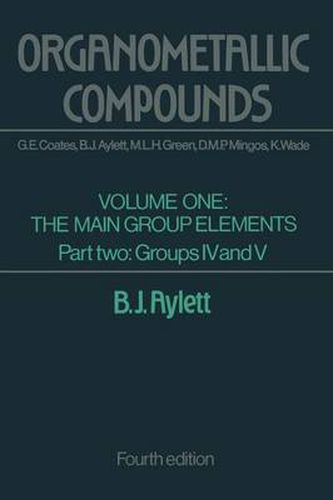Readings Newsletter
Become a Readings Member to make your shopping experience even easier.
Sign in or sign up for free!
You’re not far away from qualifying for FREE standard shipping within Australia
You’ve qualified for FREE standard shipping within Australia
The cart is loading…






This title is printed to order. This book may have been self-published. If so, we cannot guarantee the quality of the content. In the main most books will have gone through the editing process however some may not. We therefore suggest that you be aware of this before ordering this book. If in doubt check either the author or publisher’s details as we are unable to accept any returns unless they are faulty. Please contact us if you have any questions.
A very large number of organo derivatives is formed by the Group IV ele ments silicon, germanium, tin, and lead. In comparing the general properties of these elements, Table 1. 1 shows that the first ionization energies decrease (though not in a regular way) with increase in size and atomic number, con sistent with the general increase in metallic character of the elements. Electro negativity values (which have been the subject of considerable controversy) show no clear trend. Although purely inorganic compounds of tin(n) and leaden) are well known, almost all organo Group IV derivatives show an oxidation state of IV. Bonds to carbon become weaker on passing from silicon to lead, as do the element-element bonds themselves. With any particular element M (M = Si, Ge, Sn, or Pb), there is a small decrease in bond energy in the order: M-Ph > M - Me > M - Et. Although accurate data for organo derivatives are lacking, strengths of bonds to other elements probably decrease in the order: M-F> M-O > M-CI > M-H ~ M-N ~ M-S ~ M-Br > M-I, while for a particular element X, the order is: Si-X > Ge-X > Sn-X > Pb-X. It is therefore understandable that reactions leading to Si-F, Si-O, or Si-CI bonds are especially favoured in a thermodynamic sense.
$9.00 standard shipping within Australia
FREE standard shipping within Australia for orders over $100.00
Express & International shipping calculated at checkout
This title is printed to order. This book may have been self-published. If so, we cannot guarantee the quality of the content. In the main most books will have gone through the editing process however some may not. We therefore suggest that you be aware of this before ordering this book. If in doubt check either the author or publisher’s details as we are unable to accept any returns unless they are faulty. Please contact us if you have any questions.
A very large number of organo derivatives is formed by the Group IV ele ments silicon, germanium, tin, and lead. In comparing the general properties of these elements, Table 1. 1 shows that the first ionization energies decrease (though not in a regular way) with increase in size and atomic number, con sistent with the general increase in metallic character of the elements. Electro negativity values (which have been the subject of considerable controversy) show no clear trend. Although purely inorganic compounds of tin(n) and leaden) are well known, almost all organo Group IV derivatives show an oxidation state of IV. Bonds to carbon become weaker on passing from silicon to lead, as do the element-element bonds themselves. With any particular element M (M = Si, Ge, Sn, or Pb), there is a small decrease in bond energy in the order: M-Ph > M - Me > M - Et. Although accurate data for organo derivatives are lacking, strengths of bonds to other elements probably decrease in the order: M-F> M-O > M-CI > M-H ~ M-N ~ M-S ~ M-Br > M-I, while for a particular element X, the order is: Si-X > Ge-X > Sn-X > Pb-X. It is therefore understandable that reactions leading to Si-F, Si-O, or Si-CI bonds are especially favoured in a thermodynamic sense.